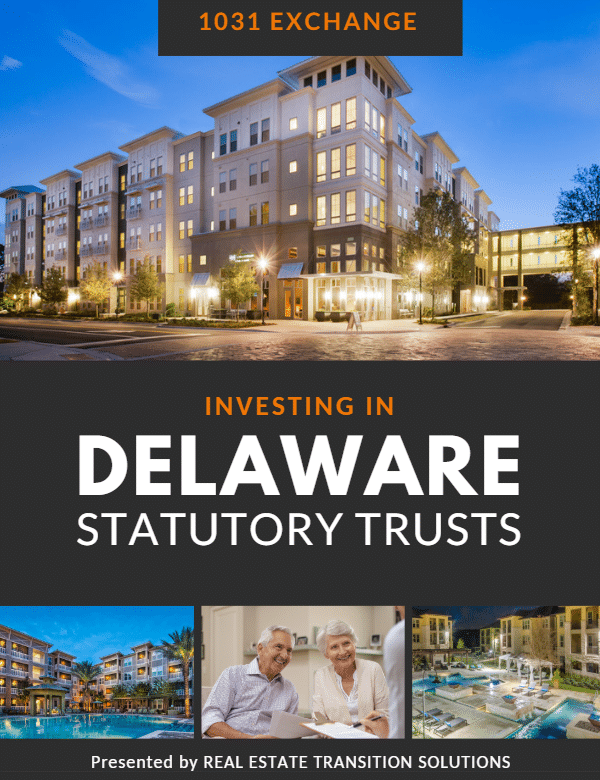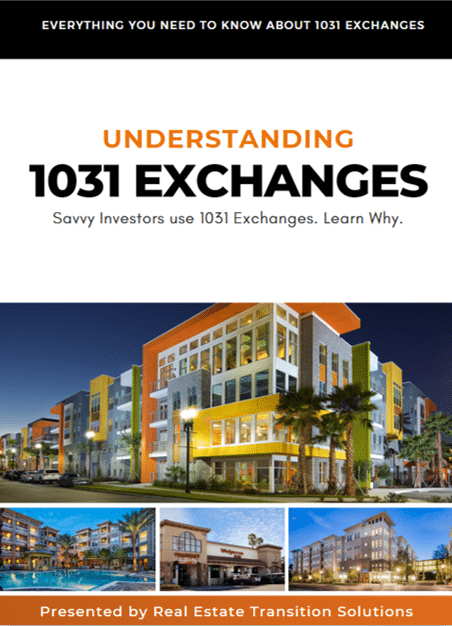1031 Exchange Glossary
Key 1031 Exchange Topics Explained
There are many unfamiliar terms when learning about 1031 exchanges and like kind exchanges. We’ve compiled some of the most common terms in our 1031 Exchange Glossary. Each term explained.
There are many unfamiliar terms when learning about 1031 exchanges and like kind exchanges. We’ve compiled some of the most common terms in our 1031 Exchange Glossary. Each term explained.
Delaware Statutory Trust
What is a Delaware Statutory Trust?
A Delaware Statutory Trust is a legal entity designed to hold institutional investment real estate that is actively managed by professional real estate firms. DSTs allow individual investors to perform a tax-deferred 1031 Exchange into a “beneficial interest” of the trust, also referred to as a “fractional interest” in a larger property or portfolio of multiple properties. Each individual DST is property-type specific. Typically, DSTs hold the following property types: multi-family apartments, essential net-lease retail, self-storage, net-lease medical office, industrial properties, student housing, senior housing or memory care.
DST managers, also referred to as the “Delaware Statutory Trust sponsors”, acquire the DST real estate and take care of all management activities, including structuring the DST, securing the long-term financing, day-to-day management decisions, financial and tax reporting, and the ultimate sale of the DST properties.
DSTs, as we know them today, were established through the Delaware Statutory Trust Act in 1988. Beneficial interests in Delaware Statutory Trusts were approved as “like-kind” real estate by the IRS in 2004 through the release of IRS Revenue Ruling 2004-86. The revenue ruling created a much-desired option for investment real estate owners who want to defer capital gains tax on real estate investment property through a 1031 Exchange, but do not want to assume the responsibility of day-to-day management. Furthermore, the Revenue Ruling allowed individual investors to pool their capital to own larger, higher-quality properties that would be too expensive for most single investors to acquire by themselves.
How Does an Exchange for DST Real Estate Work?
A DST 1031 Exchange begins with a professional real estate firm acquiring institutional quality DST real estate to be included in the trust. Once acquired, the trust is structured to allow accredited Investors the option to purchase beneficial interests in the trust with either cash investments or 1031 Exchange proceeds. Delaware Statutory Trust sponsors manage the DST property for the duration of the DSTs’ life, generally 3-10 years. Once the DST property is sold, the investors receive all sales proceeds and can choose to either pay tax on their proceeds, perform another 1031 Exchange into any investment property, or a combination of the two.
Delaware Statutory Trust Pros and Cons
For accredited* investment real estate owners who are considering selling their appreciated property, it may be beneficial to consider a DST as a replacement property when utilizing a tax-deferred 1031 Exchange. DSTs provide a unique and flexible solution to investment real estate owners looking to defer capital gains tax on real estate investment property while eliminating the active management of directly owned, Fee-Simple Property.
The following characteristics of DST ownership make these “fully structured and available” properties an option worthy of consideration for Exchange proceeds:
- DSTs are qualified 1031 Exchange properties
- Ownership requires no active management
- DST real estate tends to be high-quality “institutional” real estate
- DSTs often have low minimum investments
- Exchange proceeds can be diversified among multiple DSTs
- DST real estate has competitive potential cash flow, generally paid monthly to the owners
- DSTs have very low risk of not closing and invalidating an Exchange
Delaware Statutory Trusts are investments in real estate subject to the same market, leasing and competitor risks of traditional property. Most DSTs are illiquid and are more appropriate for long-term investments – typically 10 years or greater.
For a more comprehensive look at DSTs, including reviewing any associated risks, download our FREE guide, “Investing in Delaware Statutory Trust (DSTs)”.
Tenants-in-Common Property
What is Tenants-in-Common Property?
Tenants-in-Common (TIC) is a form of ownership that allows for an investor to own an undivided fractional interest in a larger property, similar to that of the Delaware Statutory Trust, but with less restrictions and parameters placed on the property as outlined in our FREE downloadable guide, “Investing in Delaware Statutory Trusts”. 1031 Exchange TIC Properties are worth considering for accredited* investors who are more interested in potential appreciation through a value-add property as opposed to current income and diversification. Investment minimums for Custom 1031 Exchange TIC Properties are generally $1M.
1031 Exchange for TIC Property
We work with several real estate firms who structure and allow investors to exchange into Custom 1031 Tenants-in-Common properties. Generally, these properties are value-add in nature and will either substantially improve a property following an acquisition, redevelop the property, or work through renegotiating leases. Often, the number of investors allowed in a 1031 TIC is limited. Also, one investor may be a fund, owned and operated by the parent real estate firm. Custom TIC properties differ from one another in terms of the property type acquired and investment thesis of the real estate firm managing the TIC.
Benefits of Tenants-in-Common Property
Custom Tenant-in-Common Properties can present a tremendous opportunity to utilize Exchange dollars to acquire a fractional interest in a larger property and gain access to the skills and expertise of sophisticated, opportunistic national real estate firms. The firms we work with hold extensive track records that consist of opportunistic and value-add acquisitions. Generally, they co-invest both their managed funds ‘capital and principles’ capital alongside our clients, aligning their interests throughout the duration of the investment. Custom 1031 Tenants-in-Common Properties tend to have a higher investment minimum but are an option worth considering for investors looking for a shorter investment timeline, refinance opportunities, and greater potential appreciation.
Net Lease Property
What is a Net Lease Property?
Net Lease Property is a subcategory of Fee-Simple Property and includes all Fee-Simple Property with a long-term structured net lease. A net lease is a lease that is typically long-term in nature, ranging generally anywhere from 3 to 50 years. Within a net lease arrangement, the tenant agrees to bear the majority of the operating costs associated with the property. Generally, Net Lease Property falls in the following property types: retail, commercial office, medical office, services, food services, financial institutions/banks and gas stations.
How Does It Work?
Often Net Lease Property are built to suit for specific tenants, customized to the tenant’s needs and specifications. Once constructed, the tenant (often a large corporate entity) will sign a long-term lease with language defining what costs (if any) the landlord will be responsible for and what the tenant will be responsible for. Absolute Net Lease Property have no management responsibilities held by the owner of the property. Triple Net Lease (NNN) means that generally the tenant is responsible for all operating expenses with the exception of limited structural repairs and roof repairs. Double Net Lease (NN) generally means the property owner is responsible for the structure, roof and one major operating expense item – usually either insurance or property taxes. Due to the fact the leases are long-term in nature, they usually have built-in rent escalators with the intent of, at a minimum, keeping up with inflation.
Benefits of Net Lease Property
Owners predominately acquire Net Lease Property for the stable, income potential that results from a long-term lease arrangement with a with a credit worthy tenant. Furthermore, due to the custom nature of the construction, owners tend to have limited bargaining power when negotiating lease renewals. In addition to the income and limited management requirement, the ability to control the financing associated with the property is also a benefit. While income is a worthy benefit, it should also be noted that Net Lease Property is sensitive to interest rate risk. Traditionally, Net Lease Properties have struggled from a value standpoint during increasing interest rate environments.
Fee-Simple Property
What is Fee-Simple Property?
Fee-Simple Property is a broad category that includes all investment property owned outright by the investor. Fee-Simple Property includes all property types, from residential rentals, multi-family apartments, commercial office, self-storage, raw land, etc. Most of the properties owned by potential Exchangers today fall under this category. Fee-Simple Property provides an investor all the risks and rewards of owning investment real estate. Typically, the owner can make all operating decisions regarding the property, is personally named on any debt associated with the property, and bears all liability resulting from managing the property.
How Does It Work?
Fee-Simple Property is not limited to property owned by a single investor. Often Fee-Simple Property is owned in a co-ownership arrangement such as a multiple member LLC, partnership or Tenant-in-Common arrangement. These co-ownership arrangements must be considered and potentially restructured when Exchanging into or out of a property, if the owners want to go different directions. We work extensively with co-owned properties to ensure the entity and transaction is structured in a tax-efficient manner and can best address the objectives of the owners.
Benefits of Fee-Simple Property
Owners acquire Fee-Simple Property for many reasons. Common Fee-Simple Property scenarios include:
- Selling stabilized properties to Exchange into properties with value-add potential
- Consolidating multiple properties into a single, larger property
- Exchanging into multiple smaller properties for diversification or estate planning purposes
- Exchanging into single-family rental properties to be eventual primary residences or vacation homes
Objectives are different for each investment property owner. Utilizing a Fee-Simple Property in a 1031 Exchange may be a good way to address your objectives, however it should be noted that acquiring Fee-Simple Property can at times be difficult due to the rigid timeline of a 1031 Exchange.

